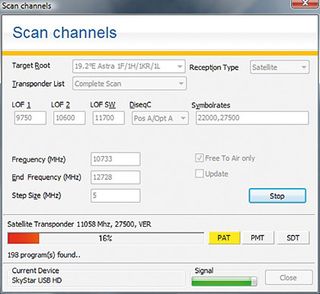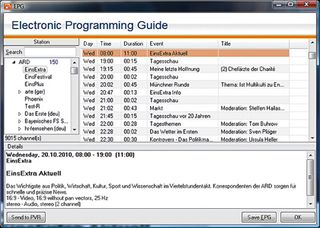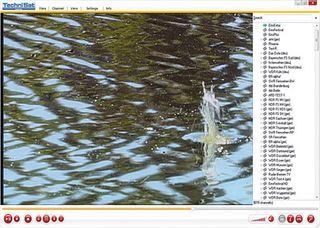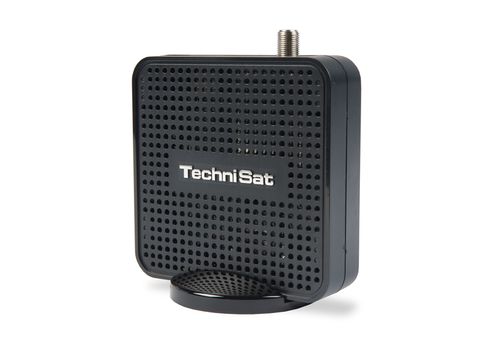TechRadar Verdict
Pros
- +
USB connectable
- +
Picture and sound quality limited by PC hardware
- +
Recordings can be shared over a network
Cons
- -
Glitches and use flaws
- -
Slow scanning
- -
Recording not as flexible as it could be
Why you can trust TechRadar
Although some PC TV tuners are designed to be fitted internally, the Windows-compatible SkyStar USB HD featured here is a USB 2.0 device. Not only does this ease installation, but also it ensures that the advantages of such an idea are available to notebook users.
The SkyStar USB HD is designed for use with FTA channels, and has no conditional access hardware support. However, you can buy external card readers that plug into a PC via USB. DiSEqC 1.0 is supported, for selection of up to four satellites.
Build and connectivity
The hardware takes the form of a compact black lozenge containing a DVB-S/S2 tuner, which sits neatly on its desk stand. On the rear are a standard F-connector for your dish/LNB, a 12V inlet (the necessary mains adapter is supplied) and the USB connection that provides the umbilical link between PC and receiver.
A remote control unit is included. Annoyingly, this takes CR2032 lithium cells, which are more expensive and trickier to find than the usual AAAs. Also supplied is a CD-ROM containing drivers and application software.
Among the latter is a cut-down TE ('Technisat Edition') version of the very capable DVBViewer desktop TV software – and a simple 'Eve' editing program that allows you to, for example, remove the ads from recordings.

TE's transport-stream (.TS) files are supported here, although HD isn't. An advantage is that the drivers are BDA-compliant. In plain English, this means that the SkyStar USB HD can be used with a wider range of desktop TV software including the full version of DVBViewer.
Setup
The SkyStar USB HD is easy to set up. Plug it in and, after Windows recognises the device, insert the CD-ROM for driver and application installation. It's then a case of running DVBViewer TE.
A database covering a number of popular satellites (including Astra 1x/2x and Hot Bird) is pre-installed, meaning that you can be watching TV within minutes. Scanning a satellite for new channels is easy, although you don't get any of the more flexible search options of enthusiast-grade gear.

You can specify a frequency/transponder, polarity and symbol rate – and whether all channels, or just FTA ones, should be found and stored – but that's about it.
With DVBViewer TE no provision has been made for features like PID entry/modification (a feature of the full DVBViewer) or blind search. You can specify step size, but this seems to have little effect as scanning ignores your input and works through the preset transponder lists as usual.
Basic use
The software, of course, provides much of the functionality. DVBViewer TE lacks some of the full software's features, such as DVD support, screenshot capture and third-party plug-in compatibility. The lack of compatibility with various brands of PC remote isn't really an issue, given that Technisat supplies a handset.
Nevertheless, DVBViewer TE gives you all of the basics – the selection, viewing/auditioning and recording of TV and radio channels. Channels are grouped by satellite and provider in the channel list – one or more can be added to a single favourites list. You can home in on a channel by typing all or part of its name.
PVR and multimedia
As with all other PVRs, a timeshift mode allows you to pause the current channel and then resume viewing at your convenience. Teletext is supported too, as are an EPG and windowed/full-screen viewing.

Playback of existing recordings (or compatible multimedia files) while new programmes are being captured is allowed. Engage 'multicast' and you can record and view different programmes if they're carried by the same transponder.
A patch for DVBViewer can be downloaded from Technisat's website. This converts 'side-by-side' 3D broadcasts, like the FTA test-transmissions on the Astra 3A satellite (the box is not Sky-compatible), into anaglyphs that can be viewed on any monitor or TV set connected to your PC. Glasses are not included but we were supplied with a robust pair with the requisite red and green lenses. These are, alas, difficult to wear if you already wear spectacles.
Performance
Ultimately, this will be restricted by the performance of your PC and ancillary componentry. With our regularly updated Yoyotech PC, which is equipped with a quad-core Intel processor and decent ATi graphics card, pictures from FTA SD and HD channels looked superb. They're crisp, dynamic and accurately coloured.
But there are caveats. On occasions, you could view a channel yet it would refuse to record. And even with our fast PC, HD channels would frequently 'glitch'. In addition we sometimes got a 'hardware not available' message.
3D is quite interesting. Yes, this Technisat system does give you some depth, albeit in a 'cardboard cut-out' sort of way. Coloured outlines spoil sharply defined objects and viewing can be quite fatiguing after a while.

Sound quality is also good, but if you have a home cinema receiver we recommend using the digital audio output should your PC have one; doing so opens up the world of multichannel Dolby Digital, from channels that broadcast it.
Satellite scans are at a snail's pace so it's just as well you don't have to do this very often. Switching between channels is also on the unresponsive side compared with today's stand-alone receivers.
Follow TechRadar Reviews on Twitter: http://twitter.com/techradarreview

